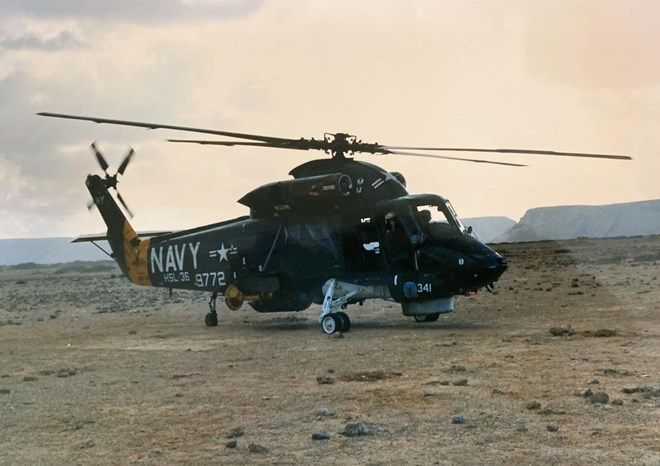Santa Maria times
Monday August 16, 2021

In the early 1980s, I served as an aircrewman on a U.S. Navy Kaman SH-2F Seasprite helicopter attached to HSL 36, a helicopter squadron based at Naval Station Mayport, near Jacksonville, Florida.
It was a medium-size helicopter with a standard crew of three: two pilots, and one aircrewman; however, during search-and-rescue missions, we would carry two aircrewmen in case one had to jump into the water to perform a rescue and the other to operate the rescue hoist.
We typically deployed on destroyers and frigates but not aircraft carriers.
Our mission was to conduct Anti-Submarine Warfare (ASW), ship surveillance and numerous other jobs that a helicopter was naturally able to do, like picking up the mail from the aircraft carrier and delivering it to the smaller ships in the battle group.
On Oct. 16, 1984, we bid farewell to Florida as we sailed for a six-month cruise to the Indian Ocean on the USS Estocin (FFG-15), an Oliver Hazard Perry class of guided-missile frigates built by Bath Iron Works in Maine. Estocin was also homeported at Mayport.
We passed through the Strait of Gibraltar into the Mediterranean Sea before passing through the Suez Canal on Nov. 8.
We entered the Red Sea, where we conducted an underway turnover with USS Stark (FFG-31). A few years later, in 1987, while in the Persian Gulf, Stark was struck by two Iraqi Exocet missiles, killing 37 sailors and wounding 21. The frigate's crew was able to sail to Bahrain in the Persian Gulf, and the ship was eventually able to return to active duty after repairs in the United States.
During most of November and December, we operated in the Northern Arabian Sea and the Persian Gulf. During this period, the USNS Harkness (AGS-32), a research ship built to operate for the oceanographer of the Navy, was gathering survey data to create detailed navigational charts of the coastal waters of Somalia on the Horn of Africa.
The ship had a utility UH-2A, Seasprite helicopter stripped of all its tactical equipment, like radars, Magnetic Anomaly Detector (MAD) and sonobuoy processors, allowing it to carry more personnel and equipment.
Their helicopter transported survey teams and their equipment from one site to another along the Somali coast. Their Seasprite sucked in blowing sand into both of its turboshaft engines during one of these transfers, rendering them unusable. Their aircraft maintainers had to replace both engines on the beach, which would take about a week to complete.
The captain of the Harkness asked if our helicopter detachment could help move their civilian survey teams and assist in repairing their helicopter trapped on the beach. We were given permission by our command to do so. Over the next few days, we got to transport groups of civilian surveyors and all their equipment from one location to other sites miles away.
Most of their equipment was put in cargo nets attached by a long lanyard connected to a cargo hook on the bottom of the helicopter.
To prevent damage to our Seasprite, we would hover about 50 to 60 feet above the ground and lower the surveyors with a survivor's sling (horse collar) that wrapped around their chest and under their arms and was connected to the helicopters' rescue hoist cable by way of the V-ring on the rescue hook.
I always ensured that the retainer straps on the survivor's sling were connected to prevent the person from slipping out of the horse collar and falling to the Earth. To this day, I still cringe about one surveyor in a bright orange vest who disconnected the quick ejector connector on his retraining straps halfway down because he said it felt uncomfortable. As he looked up at me, I'm sure he could see my look of intense anger and then relief when he reached the ground.
Overall, to move all the survey and camping equipment from one location to another would take up to five flights to complete. After each flight, the number of Somalis watching us would gradually increase with looks of intense curiosity.
A surveying rod had slipped out of the cargo net and landed on the desert floor on one of the transfer flights.
To retrieve it and an empty Coca-Cola can, we decided to land on the desert floor. After our landing gear settled on the tan-colored ground, I took out my Canon AE1 camera and took a photograph of our helicopter with Lt. Joe Hinson and our Officer-In-Charge (OIC) Lt. Cmdr. Cosgrove. I turned 180 degrees and photographed the locals with the sun in their faces.
There's a fierce beauty in that part of the lightly populated Somali desert along the Indian Ocean. The contrast between the ocean and desert was remarkable.
Our detachment maintainers and the Harkness mechanics were able to replace the helicopter's engines while on the beach, and our services were no longer needed.
We headed back to the Persian Gulf. President Ronald W. Reagan called our ship from the White House to wish us happy holidays on Christmas Eve. We made our last transit through the Strait of Hormuz in March 1985 and headed westward halfway around the world to Mayport.
We crossed the Atlantic Ocean with three other ships: USS John Hancock (DD-981), Hayler (DD-997) and McInerney (FFG-8) and slammed into a massive North Atlantic storm that generated enormous waves.
From our vantage point, the other three ships, especially the smaller frigate, seem to spend more time under the water than above it. Our boat pulled into Ponta Delgada in the Azores and waited for the storm to passed. We arrived back in Mayport in April.